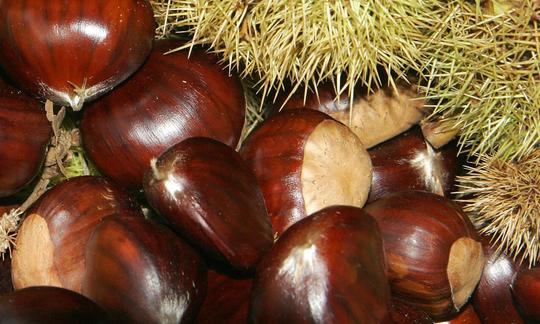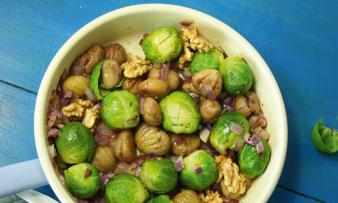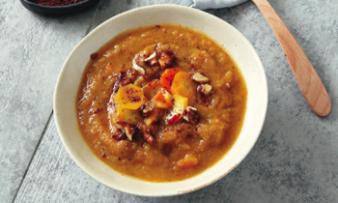Table of contents
The European chestnut (the nut of the sweet chestnut Castanea sativa ) can be eaten raw or cooked. It roasts well unpeeled and has a wide range of uses. It can be used as a side dish or as an ingredient in desserts. It can also be used to make gluten-free flour, which serves as a grain substitute.
Use in the kitchen:
The use of sweet chestnuts is just as varied as that of the closely related and more cultivated chestnuts . Compared to chestnuts, sweet chestnuts are not as easy to peel, are smaller and do not have as intense a flavor. However, their use in the kitchen is almost identical.
In the past, the fruits of sweet chestnuts were considered the main food in the growing areas. Cooked chestnuts are ideal as a side dish due to their high starch content. Making puree from sweet chestnuts is just as easy as making it from potatoes . Cooked sweet chestnuts are also suitable as the main ingredient in a creamy soup, in stews or as a spread on bread. You can even buy "milk" or drinks made from sweet chestnuts.
Can you eat sweet chestnuts raw or are they poisonous when raw? You can eat peeled sweet chestnuts raw. You can also eat chestnuts raw, as they are easier to peel. It is advisable to store raw sweet chestnuts for a few days after harvesting so that the tannin content is reduced. If you soak the raw chestnuts in water for around 2 hours, you can peel them more easily. Use a knife to make a cross-shaped cut in the hard shell and also remove the brown inner seed skin. Sweet chestnuts are not poisonous when raw, but they are a little harder to digest, which is why it is important to chew them well. The taste of a raw sweet chestnut is sweet.
One way to process (raw) chestnuts is to make flour. To do this, you grind the raw, peeled and dried chestnuts several times to make very fine flour. This flour can be used for gnocchi or pasta. Bread and pastries work best when mixed with other flours, as chestnuts lack gluten. Coarsely ground flour can be prepared like polenta. Chestnut flakes taste great in breakfast cereal.
The sweet, nutty chestnuts can be roasted with the shell on, just like chestnuts. The roasting process gives them a special taste: roasted, peeled and still warm, they taste great as a snack or in a salad, for example.
There are also a variety of desserts made from chestnuts: ice cream, marrons glacés, mousse, soufflé, cream or vermicelles (Swiss dessert made from chestnut puree). Traditionally there is chestnut bread, chestnut cake (castagnaccio) or chestnut fritters (castagnacci), pancakes (necci), pudding or ballotte (chestnuts boiled in water and flavoured with fennel seeds and bay leaves).
In Italy and France, a creamy liqueur is made from sweet chestnuts, and in Corsica and Switzerland, a special chestnut beer is known. 1
Recipes with sweet chestnuts or chestnuts:
Try these vegan recipes with the closely related chestnuts: Autumnal chestnut and carrot bisque with garam masala from the book "Vegans go Nuts" by Celine Steen or Brussels sprouts with chestnuts and fennel seeds from the book "Regional winter cuisine - soy and wheat free, vegan" by Miriam Emme.
Roasted chestnut preparation:
Soak the raw chestnuts in cold water for about 1 hour. Then cut each chestnut crosswise on the bulbous side with a sharp knife. Preheat the oven to about 250 °C. Put the chestnuts on a tray, together with a heat-resistant cup full of water, so that the nuts do not dry out too much. Put the tray on the middle rack in the oven. After 30 minutes in the hot oven, the chestnuts are ready to eat. Let them cool down a little and then enjoy a starchy snack. Another tip is to put a wet tea towel over the chestnuts after 20 minutes and then leave them in the hot oven for another 10-15 minutes. But you have to make sure that the towel does not start to burn. 2
Vegan recipes with chestnuts can be found under the note: " Recipes that have the most of this ingredient ".
| Not only vegans or vegetarians should read this: Vegans often eat unhealthily. Avoidable nutritional mistakes . |
Shopping - where to buy?
In the autumn and winter (season) you can find sweet chestnuts at some weekly markets and certainly in every supermarket. Not only large retailers such as Coop , Migros , Volg (CH), Edeka , Rewe (D), Spar , Hofer and Billa (AT) stock the nuts, but also discounters such as Aldi and Lidl offer various (packaged and loose) sweet chestnuts. Pre-cooked sweet chestnuts are often vacuum-packed, placed in jars or cans. These can then be easily reused, but are not suitable for roasting in the oven. In addition, ready-made or semi-finished products often contain additives such as thickeners (guar gum, xanthan), which is why these should be avoided.
Dried chestnuts are peeled, air-dried chestnuts that are ideal for storing. Before eating, you soak them in water overnight and then boil them for an hour the next day. They can then be used in many dishes.
Found in the wild - Season:
Wherever sweet chestnuts are cultivated, they also grow wild. Mainly found in the Mediterranean region, they also thrive in the wild in southwestern Germany. These wild forms bear significantly smaller fruits, and the fruit cup (outer shell) is also significantly smaller at 5-6 cm than in cultivated forms. 1
In principle, collecting chestnuts is permitted. The law can limit the amount of chestnuts that can be collected or impose a temporary ban on collecting. For example, the canton of Ticino has imposed a ban on collecting in certain well-maintained selves (fruit groves) until November 11th. The owner of a managed forest can also prohibit collecting, provided that he clearly indicates this with a ban. On chestnut trails promoted by tourists, it is usually permitted to collect chestnuts to the left and right of the trail. Please wait until the chestnuts have fallen from the tree: before then they are not ripe enough and hitting them down with sticks or shaking them down is prohibited. The collecting season is around the end of September to the end of October.
Storage:
The high sugar and water content of fresh chestnuts makes them easily perishable. The risk of mold is very high, so they should be consumed or preserved as quickly as possible. In general, chestnuts last for about 1 week at room temperature, or up to 4 weeks in the refrigerator. To do this, put them in a perforated plastic bag so that they do not dry out too quickly. Peeled and blanched, they can even be frozen (for about 12 months).
There are many different ways of preserving chestnuts. The traditional method is the "Ricciaia" method, which is now only used in Turkey. The fruits are piled up with the shell and fermented, which means they can be kept for several months. Today, hydrotherapy is more commonly used for preservation: the chestnuts are placed in cold water for a few days, the beginning of lactic acid fermentation preserves the chestnuts and then they are dried. The shelf life can be extended by storing them in a cool place, drying them, fumigating them with methyl bromide, storing them in a carbon dioxide atmosphere or smoking them. 1
Ingredients - nutritional value - calories:
How many calories does a raw chestnut have? The energy content of chestnuts (raw) is around 210 kcal/100g. Although chestnuts are nuts, their fat content is particularly low at around 2%. The carbohydrate content, however, is very high at around 46%. After cooking or roasting, some of the starch is converted into sugar, giving them a sweet taste. The proteins they contain (around 2.4%) are free of prolamine and glutenin, meaning they are gluten-free.
European chestnuts also provide vitamin C , folic acid , pyridoxine (vitamin B 6 ), thiamine (vitamin B 1 ) and riboflavin (vitamin B 2 ). They also contain nutrients such as potassium , phosphorus , manganese and copper . 3
The complete ingredients of sweet chestnuts (raw), the coverage of the daily requirement and comparison values with other ingredients can be found in our nutrient tables. In the article Nutrients explained you will get a detailed insight into the topic.
Health aspects - effects:
Sweet chestnuts are an excellent source of energy. The complex carbohydrates fill you up quickly and blood sugar only rises very slowly after eating. The potassium they contain helps to strengthen the nerves and thus avoid stress. Potassium is also good for neutralizing excess sodium and helps to avoid cardiovascular diseases or cardiac arrhythmias. 4.5
Sweet chestnuts are gluten-free, which is why their flour is very popular with people with gluten intolerance (celiac disease). However, due to the lack of gluten, it is not good for baking on its own and you have to mix it with another flour.
Occurrence - Origin:
The origin of the sweet chestnut is probably in Asia Minor or the Caucasus. Since ancient times, the sweet chestnut has been cultivated throughout the Mediterranean region 6 and in the northern neighboring areas, so its exact distribution area cannot be determined. The altitude limit is around 1000 m in the Alps, 1500 m in Sardinia and Sicily and 1800 m in the Caucasus. The sweet chestnut can also be found occasionally in southern Scandinavia. In East Asia and Portugal, the Chinese chestnut (or soft chestnut, Castanea mollissima ) and the Japanese chestnut ( Castanea crenata ) are grown. In Europe, hybrids of the European and Japanese chestnut are increasingly found, as they are more resistant to chestnut cancer. This tree cancer has been massively weakening the stocks since the beginning of the 20th century. 1
Cultivation - Harvest:
Sweet chestnuts are deciduous trees that very rarely grow into shrubs. On average they reach a height of 20-25 m in high forests, the average trunk circumference is 2 m (sometimes even 4-6 m).
There are different ways of growing sweet chestnuts: The most extensive way is in high forests. Here the trees grow from seeds. In a high-stem plantation (selve), the trees are grafted onto a suitable rootstock. The chestnut trees then have a shorter trunk and a large crown. Around 80-100 trees are planted per hectare. If the trees are a little taller (such as in Ticino or Corsica), cattle can graze underneath them. Chestnuts are also grown in low forests, where the trees produce crops for between 15 and 40 years. In the past, this method was associated with viticulture, as the chestnut wood was used for wine barrels. 8
When unripe, the fruit cups have green, pointed spines that later turn yellow-brown. The fruit cup of cultivated chestnuts has a diameter of up to 10 cm and contains up to three fruits. 1
Danger of confusion:
Horse chestnuts ( Aesculus hippocastanum ) can easily be confused with sweet chestnuts ( Castanea sativa ), but they are not related. Horse chestnuts have fingered, compound leaves and the rounded chestnut fruits are in a green, prickly capsule with thick thorns. In contrast, sweet chestnuts are flatter and have a slightly hairy tip. The thorns are finer and the trees have simple leaves.
Horse chestnuts are inedible and slightly poisonous. Digestive disorders can occur due to the saponins and glucoside aesculin they contain. 14
Sweet chestnuts and marrons are often confused, and these names are often used synonymously. Marrons are a special breed of sweet chestnuts.
However, the use of the terms is not clearly defined. In France, the term "marron" defines those nuts in which no seed coat has grown in. However, less than 12% of the nuts are split, i.e. the seed coat encloses both cotyledons individually. In Italy, the term "marroni" refers to varieties that are particularly large, of the best quality, have a slightly elongated shape and a reddish, shiny shell with dense stripes and only have a small scar. The taste is sweet, they are not split and are easy to peel. Chestnuts usually contain only one, maximum two fruits per fruit cup, which is why they are rounder. 7
General information:
Sweet chestnuts are the fruit of the sweet chestnut ( Castanea sativa ); there is no specific Latin term for the nut itself. This tree is the only European representative of the chestnut genus ( Castanea ). European sweet chestnuts can reach an age of around 200 years; in Western Europe there are trees that are over 1000 years old. 8
In addition to the nuts, there is also chestnut honey, which is amber in color or sometimes even darker and has a very aromatic taste. The leaves of the sweet chestnut are sometimes used for aftershave lotions or for dyeing fabrics. 7
Leaf extracts from European sweet chestnuts are said to be effective against MRSA bacteria. MRSA bacteria are multi-resistant bacteria against which conventional antibiotics (e.g. penicillin) are no longer effective. 9,10
Chestnuts are a special feed for pigs, especially in Spain, southern Italy and Corsica. This is said to give the meat produced a special taste. 7
The leaves were used as bedding in the stables or as fertilizer. In folk medicine, the leaves were used to treat coughs, wounds or diarrhea. 8
The wood of sweet chestnuts is generally very popular. The warm, golden-brown tone is reminiscent of oak, although the grain is not as strong and it is very easy to work with. 11 High forest wood is used for furniture, window and door frames. Due to its weather resistance, it is also suitable for telegraph poles and similar. Low-growing trees are processed into garden fences, pasture posts, wine and liquor barrels. Chestnut wood was previously used for making charcoal or as firewood. 12 It can also be used for railway sleepers, ceiling and roof beams, for slope and avalanche structures and in shipbuilding. 13
Alternative names:
Alternative names for sweet chestnuts (nuts) and chestnuts (trees) are: Ketschen, Keschde (Palatinate), Keschtn (South Tyrol), Chataignes, Castane, Castanen, Castanien, Chestbom, Chestinna, Kesten, Kestenbaum, Kestenenbaum, Kestenenboum, Kestenne, Kestenzbom, Kesteza, Kestina, Kestinneboum, Kestnitz, Kiestebum, Köstenbaum, Marren, Marronen, Maronen, Maroni (Austria), Marroni (Switzerland), Macronen, Questenboum. 1
Literature - Sources:










Comments